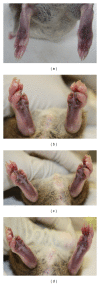Therapeutic efficacy of vitamin E δ-tocotrienol in collagen-induced rat model of arthritis
- PMID: 25114906
- PMCID: PMC4119727
- DOI: 10.1155/2014/539540
Therapeutic efficacy of vitamin E δ-tocotrienol in collagen-induced rat model of arthritis
Abstract
Rheumatoid arthritis (RA) is a chronic, systemic, inflammatory disease primarily involving inflammation of the joints. Although the management of the disease has advanced significantly in the past three decades, there is still no cure for RA. The aim of this study was to determine the therapeutic efficacy of δ-tocotrienol, in the rat model of collagen-induced arthritis (CIA). Arthritis was induced by intradermal injection of collagen type II emulsified in complete Freund's adjuvant. CIA rats were orally treated with δ-tocotrienol (10 mg/kg) or glucosamine hydrochloride (300 mg/kg) from day 25 to 50. Efficacy was assessed based on the ability to reduce paw edema, histopathological changes, suppression of collagen-specific T-cells, and a reduction in C-reactive protein (CRP) levels. It was established that δ-tocotrienol had the most significant impact in lowering paw edema when compared to glucosamine treatment. Paw edema changes correlated well with histopathological analysis where there was a significant reversal of changes in groups treated with δ-tocotrienol. The results suggest that δ-tocotrienol is efficient in amelioration of collagen-induced arthritis. Vitamin E delta-tocotrienol may be of therapeutic value against rheumatoid arthritis.
Figures





Similar articles
-
The Role of Tocotrienol in Arthritis Management-A Scoping Review of Literature.Pharmaceuticals (Basel). 2023 Mar 2;16(3):385. doi: 10.3390/ph16030385. Pharmaceuticals (Basel). 2023. PMID: 36986484 Free PMC article.
-
Therapeutic effects of lactosyl derivative Gu-4 in a collagen-induced arthritis rat model.Glycoconj J. 2012 Aug;29(5-6):305-13. doi: 10.1007/s10719-012-9407-0. Epub 2012 Jun 12. Glycoconj J. 2012. PMID: 22688516
-
Anti-arthritic effect of GN1, a novel synthetic analog of glucosamine, in the collagen-induced arthritis model in rats.Inflamm Res. 2011 Dec;60(12):1113-20. doi: 10.1007/s00011-011-0375-9. Epub 2011 Aug 27. Inflamm Res. 2011. PMID: 21874354
-
Investigation of the curative effects of palm vitamin E tocotrienols on autoimmune arthritis disease in vivo.Sci Rep. 2019 Nov 14;9(1):16793. doi: 10.1038/s41598-019-53424-7. Sci Rep. 2019. PMID: 31727971 Free PMC article.
-
Amelioration of joint disease in a rat model of collagen-induced arthritis by M40403, a superoxide dismutase mimetic.Arthritis Rheum. 2001 Dec;44(12):2909-21. doi: 10.1002/1529-0131(200112)44:12<2909::aid-art479>3.0.co;2-#. Arthritis Rheum. 2001. PMID: 11762952
Cited by
-
Tocotrienol Supplementation Led to Higher Serum Levels of Lysophospholipids but Lower Acylcarnitines in Postmenopausal Women: A Randomized Double-Blinded Placebo-Controlled Clinical Trial.Front Nutr. 2021 Dec 24;8:766711. doi: 10.3389/fnut.2021.766711. eCollection 2021. Front Nutr. 2021. PMID: 35004805 Free PMC article.
-
The Role of Tocotrienol in Arthritis Management-A Scoping Review of Literature.Pharmaceuticals (Basel). 2023 Mar 2;16(3):385. doi: 10.3390/ph16030385. Pharmaceuticals (Basel). 2023. PMID: 36986484 Free PMC article.
-
Reduction of disease activity in rheumatoid arthritis by tocotrienol-rich fraction supplementation: a randomized, double-blind, placebo-controlled trial.Eur J Nutr. 2025 Jun 24;64(5):227. doi: 10.1007/s00394-025-03742-6. Eur J Nutr. 2025. PMID: 40553171 Clinical Trial.
-
Alpha-tocopherol ameliorates experimental autoimmune encephalomyelitis through the regulation of Th1 cells.Iran J Basic Med Sci. 2016 May;19(5):561-6. Iran J Basic Med Sci. 2016. PMID: 27403263 Free PMC article.
-
Tocotrienol regulates osteoclastogenesis in rheumatoid arthritis.Korean J Intern Med. 2021 Mar;36(Suppl 1):S273-S282. doi: 10.3904/kjim.2019.372. Epub 2020 Jun 19. Korean J Intern Med. 2021. PMID: 32550719 Free PMC article.
References
-
- Smith CA, Arnett FC. Epidemiologic aspects of rheumatoid arthritis. Current immunogenetic approach. Clinical Orthopaedics and Related Research. 1991;265:23–35. - PubMed
-
- Chaiamnuay S, Bridges SL., Jr. The role of B cells and autoantibodies in rheumatoid arthritis. Pathophysiology. 2005;12(3):203–216. - PubMed
-
- Romas E, Gillespie MT, Martin TJ. Involvement of receptor activator of NFkappaB ligand and tumor necrosis factor-alpha in bone destruction in rheumatoid arthritis. Bone. 2002;30(2):340–346. - PubMed
MeSH terms
Substances
LinkOut - more resources
Full Text Sources
Other Literature Sources
Medical
Research Materials
Miscellaneous

